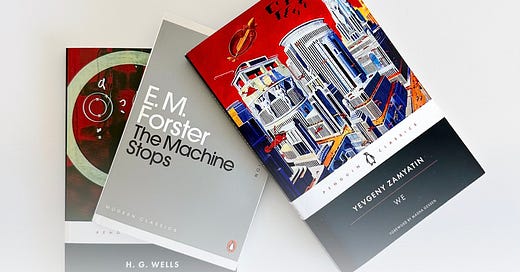Back when I read the classic We by Yevgeny Zamyatin, I made sure to try and read it through a lens of exploring early dystopians, rather than expecting a modern idea of the genre. With that, I stumbled directly into this idea of how these first demonstrations of a nightmarish society influenced each other, suggesting they are built on each other’s backs, as prequels. Sort of a “how we got here.”
Forster himself, in a 1947 collection preface, linked his short story The Machine Stops as a pseudo-prequel to The Time Machine.
Also, I went down a rabbit hole to add in what societal changes each author would’ve faced at the time of writing.
This “trilogy” explores the progression of a dystopian society, in a reverse chronology, from totalitarian control (We), through extreme technological dependence (The Machine Stops), to eventual devolution and fragmentation (The Time Machine). Each book examines the consequences of relinquishing individuality, freedom, and human connection in favor of control, order, and technological advancement, ultimately warning of the potential downfall of such a society.
📕 We by Yevgeny Zamyatin (1924) | Book 3. In a distant future, the world is governed by the One State, a totalitarian regime that controls every aspect of human life. The construction of the Integral, a spaceship designed to spread the ideology to other planets, marks the beginning of a machine designed to maintain absolute control.
Most Important Influence: The Russian Revolution and the Rise of Totalitarianism.
Impact: The Russian Revolution of 1917 and the subsequent rise of the Soviet Union under Lenin and later Stalin had a profound impact on Zamyatin. The early years of Soviet rule were marked by political repression, suppression of dissent, and an emphasis on collectivism over individualism.
Reflection in the Work: We is set in a dystopian future where the One State exercises total control over its citizens, suppressing individuality and emotion in favor of rationality and uniformity. Zamyatin's novel is a direct response to the political climate of his time, critiquing the dangers of totalitarianism and the loss of personal freedom.
📗 The Machine Stops by E. M. Forster (1909) | Book 2. The machine dominates everyday life as an all-encompassing entity that provides for every need of humanity, which now lives underground in isolated cells, from sustenance to communication, rendering human physical interaction nearly obsolete.
Most Important Influence: The Early Development of Modern Technology and Urbanization.
Impact: The early 20th century saw significant advancements in technology, including the spread of electricity, telecommunication, and the rise of urban living. These changes began to shape a society increasingly dependent on technology for everyday life.
Reflection in the Work: The Machine Stops presents a world where humanity relies entirely on a vast, omnipotent machine for all aspects of life, leading to extreme isolation and loss of individuality. Forster critiques this dependence on technology and warns of the potential dehumanizing effects of an overly controlled, technologically driven society.
📘 The Time Machine by H. G. Wells (1895) | Book 1. A Time Traveller from the 19th century arrives in this fractured future and discovers the devastating long-term consequences of the society that once relied on the machine. He learns that the technological advancements meant to create a utopia led to humanity’s devolution and moral decay.
Most Important Influence: The Industrial Revolution
Impact: The rapid industrialization and technological advancements of the late 19th century greatly influenced Wells. The Industrial Revolution brought significant changes to society, including the rise of factories, urbanization, and a stark division between the working class and the wealthy elite.
Reflection in the Work: In The Time Machine, the future world of the Eloi and Morlocks serves as an extrapolation of the class divisions and social consequences of industrialization. Wells explores the potential long-term effects of these divisions, imagining a future where humanity has evolved into two distinct species as a result of unchecked industrial and social progress.
You may now emerge from the rabbit hole I dug.





